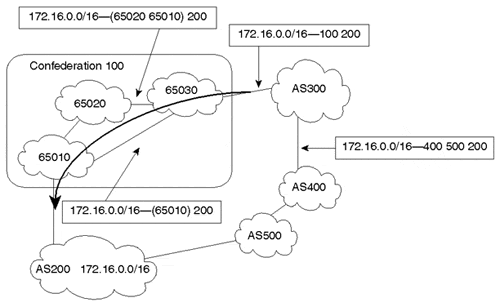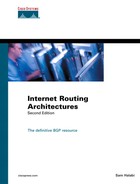Confederations
A confederation[2] is another way to deal with the explosion of an IBGP mesh within an AS. As with route reflection, confederations are recommended only for cases in which IBGP peering involves a large number of IBGP peering sessions per router.
Tip
See the section Confederations in Chapter 12.
BGP confederations are based on the concept that an AS can be broken into multiple sub-ASs. Inside each sub-AS, all the rules of IBGP apply. All BGP routers inside the sub-AS, for example, must be fully meshed. Because each sub-AS has a different AS number, external BGP must run between them. Although EBGP is used between sub-ASs, routing inside the confederation behaves like IBGP routing in a single AS. In other words, the next hop, MED, and local preference information is preserved when crossing the sub-AS boundaries. To the outside world, a confederation looks like a single AS. Figure 9-9 shows an example of a confederation.
Figure 9-9. Sample Confederation of Sub-AS Constructs

In Figure 9-9, AS100 is split into two sub-ASs: AS65050 and AS65060. The AS, as a whole, is now one large confederation, identified by a single confederation number, 100. All the sub-ASs are shielded from the outside world and can be given any AS numbers. The numbers could be chosen from the private AS range (64512 to 65534, as designated in RFC 1930[3]) in order not to use up any formal AS numbers.
As mentioned previously, inside the sub-AS an IBGP full mesh is used. EBGP is used between the sub-ASs as well as between the confederation itself and outside ASs. Confederations can easily detect routing loops inside the whole AS because EBGP is run between sub-ASs. The AS path list is a loop-avoidance mechanism used to detect routing updates leaving one sub-AS and attempting to reenter the same sub-AS. A routing update that tries to reenter a sub-AS it originated from will be detected because the sub-AS will see its own sub-AS number listed in the update's AS path.
Confederation Drawbacks
The drawback of confederations is that migration from a nonconfederation to a confederation design requires major reconfiguration of the routers and a major change in the logical topology. In addition, routing through a confederation might not take an optimal path without manually setting BGP policies. Figure 9-10 illustrates this issue.
Figure 9-10. AS Confederation Internal and External Routing

Confederation 100 is composed of three sub-ASs: 65010, 65020, and 65030. The AS path within confederation 100 is represented by the sequence of ASs and sub-ASs the route has traversed. In standard BGP, the shortest AS path determines the best path traffic will pass through. However, in a confederation, sub-ASs do not influence the overall AS path length. For instance, one prefix composed of two equal-length AS paths that each have different-length sub-AS paths could introduce suboptimal routing inside the AS because it is unclear which is the better path. From the point of view of sub-AS 65030, AS path (65010) is the same length as AS path (65020 65010); traffic inside the confederation may take either path. Additional policies would have to be set to affect routing behavior appropriately. For example, the local preference can be configured to make the AS path (65010) preferred over (65020 65010).
Because the confederation is a single AS, the path taken by external ASs through a confederation is unknown. This is misleading for ASs that base their routing policies on the AS path length. To reach AS200, AS300 will most likely prefer to go via confederation 100 because the path looks shorter than the path through AS400 and AS500. In actuality, of course, confederation 100 is not the shortest path because it includes a path via three sub-ASs (65030 65020 65010), whereas the alternative (AS400 AS500) includes only two. AS300 will never know of this pitfall unless the AS100 confederation design is disclosed.
Route Exchange and BGP Decisions with Confederations
Even though routes are exchanged between sub-ASs of a confederation via EBGP, all the IBGP rules still apply in order for the whole AS to still behave as a single routing domain. The EBGP NEXT_HOP is still carried within the AS, as is the MED and LOCAL_PREF values.
As far as the BGP decision algorithm, the only changes are in the way BGP routes to outside the confederation compared to how BGP routes inside the confederation. Without confederations, EBGP routes are preferred over IBGP routes. With confederations, we have introduced a new type of EBGP route between the sub-ASs—a confederation external route. BGP prefers routes in the following manner:
EBGP routes to outside the confederation > confederation exterior routes > IBGP routes
Therefore, if BGP has a choice between two paths to the same destination—one leading outside the confederation and one leading inside the whole confederation—BGP will pick the exterior path. Furthermore, if BGP has a choice between two paths to the same destination—one inside the sub-AS and one outside the sub-AS—BGP will pick the exterior path leading out of the sub-AS. This is, of course, assuming that all other attributes are the same.
Recommended Confederation Design
Choosing and connecting the sub-ASs randomly inside the confederation will lead to problems. Unnecessary processing might occur because each sub-AS can end up getting similar information from other sub-ASs via a single path. Besides, suboptimality will be introduced because all paths inside the AS have exactly the same length, as already discussed.
Experience has proven that a centralized confederation architecture results in the most optimal routing behavior. The centralized design means that all sub-ASs exchange information with each other through a central sub-AS backbone.
In Figure 9-11, each sub-AS interacts with only one other sub-AS. The result will be more uniform routing with respect to AS path length and route exchange within the confederation.
Figure 9-11. Centralizing Confederation

Confederations Versus Route Reflectors
Determining whether to use route reflectors or confederations is not a simple decision. Although different organizations have experienced various levels of stability with these approaches, Cisco recommends the use of the route reflector technique to solve IBGP mesh scalability issues. Actual deployments have proven that route reflectors are more flexible to implement and maintain. On the other hand, confederations could be used to run an IGP in one sub-AS independently of IGPs in other sub-ASs, which would help control the instability of large IGPs.
In some situations, route reflectors can be used in conjunction with confederations. In particular, an AS can be divided into sub-ASs that each run route reflectors internally.
Whichever approach you use, you should always understand the restrictions and behavior of each method and design your network accordingly.
